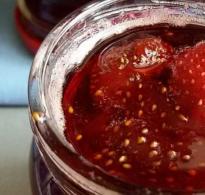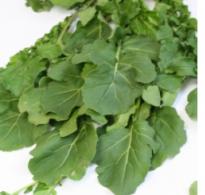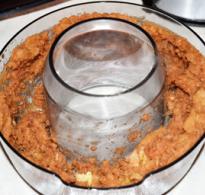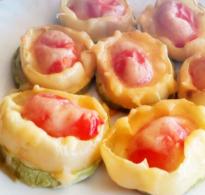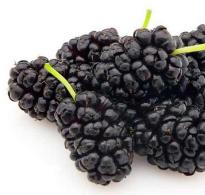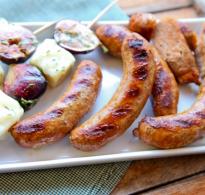Easter cake with cream step by step recipe. Creamy Easter cake
Those who love fragrant and soft Easter cakes will definitely like Easter baking, the yeast dough for which is made on the basis of sour cream. Easter cakes made with sour cream are incredibly tasty and fluffy, and most importantly, if stored properly, they will not go stale for a long time.
Easter cake with sour cream and candied fruits
Notes and Tips:
Approximately from the specified amount of products you get 2 large Easter cakes, 2 medium ones and 8 small ones.
It is better to use homemade eggs for cooking. This will have a positive effect not only on the taste of Easter baked goods, but also on their color.
The indicated amount of raw yeast can be replaced with 11 grams of dry yeast.
Butter should be added to the dough softened and never melted.
Candied fruits can be replaced with light or dark seedless raisins.
sour cream cake recipe
Ingredients:
- fat sour cream – 250 grams,
- milk – 300 ml,
- butter – 150 grams,
- raw yeast – 60 grams,
- granulated sugar – 200 grams,
- fresh eggs – 3 pcs.,
- yolk – 1 pc.,
- wheat flour - about 900 grams,
- multi-colored candied fruits - about 150 grams.
Additionally, to decorate Easter cakes you will need chilled egg whites (2 pcs.), powdered sugar (1 cup), lemon juice (2 tablespoons) and confectionery powder.
Cooking process:
Heat the milk to about 35 degrees and combine with crumbled yeast and 1 teaspoon of sugar. Mix everything thoroughly and leave at room temperature for about 10 minutes. If you have taken high-quality yeast, then during this time a lush foam will appear on the surface of the milk.

Sift 200 grams of flour through a sieve and gently stir them into the milk and yeast mixture.

Cover the bowl with the dough with a towel and leave in a warm place for about 30 minutes.
While the dough is increasing in size, you can take care of the eggs, namely, beat them together with granulated sugar into a fluffy white mass.

During this time the dough will more than double in size.

Very carefully add to it one by one: beaten eggs, soft butter and sour cream at room temperature.

Sift the rest of the flour through a sieve and mix into the dough with smooth movements.

At first, you can work with a plastic spatula, but then it’s better to handle the sour cream-based yeast dough with your hands. The finished dough should not be very stiff and stick to your hands only slightly.

Transfer it to a deep container greased or sprinkled with flour, cover with a towel and leave warm for another 60 minutes. During this hour, the sour cream yeast dough for Easter cakes will grow at least 2 times.

When this happens, roll the prepared candied fruits in a small amount of flour and stir them into the dough. Leave it warm for another 30 minutes.

Prepare molds for baking Easter cakes.
Tip: if you don’t have special metal or silicone molds for Easter cakes, then you can use metal mugs, muffin tins and other more or less suitable devices instead. The only thing is that then their bottom and walls must be lined with oiled parchment paper. Moreover, the paper should be at least twice as high as the level of the molds, so that the dough, after rising, does not leak out of them.

Fill the prepared molds no more than a third full and set aside for another 30 minutes. When the dough has risen sufficiently, brush the tops of the Easter cakes with beaten yolk and place the molds with them in an oven preheated to 180 degrees. Bake the sour cream cakes in the oven for about 40 minutes (small ones take a little less time, and large ones a little more).

Check the readiness of the browned Easter cakes with a toothpick - if it remains dry after piercing the dough, then they can be removed from the oven. It’s better to cool the cakes on their side, so they definitely won’t fall off.

To decorate Easter baked goods, beat egg whites, lemon juice and powdered sugar into a stable foam. Brush slightly cooled Easter cakes with snow-white glaze and sprinkle with multi-colored confectionery powder to taste.

Store Easter cake with sour cream in a tightly closed container (for example, in a deep saucepan). Wrap in a cloth towel.
Photo recipe for Easter cake with sour cream from Svetlana Soroka
For lipstick:
flour - about 800 g
cream – 1 glass
It is advisable to take cream with a fat content of 20% or higher
Eggs - 8 pcs.
of these we will need yolks and about half of all whites
fresh yeast – 50 g
Sugar – 1 glass
I usually take 1.5 glasses at the request of my eaters, because... they like Easter cakes to be sweet
Salt – 1 teaspoon
butter – 150 g
Vegetable butter – 3–4 tbsp. spoons
refined, odorless
cognac – 1 tbsp. spoon
optional
raisins, candied fruits, nuts - 1-1.5 cups in total
according to your desire and choice
spices - cardamom and nutmeg - to taste and desire
You can use your own set of spices, but just don’t overdo it with their quantity, because... the taste and aroma of the Easter cake itself should remain dominant
vanilla sugar - 1 sachet or to taste
saffron tincture - optional
To give the cake a bright yellow color. The tincture is prepared either with vodka or water. To do this, a small pinch of saffron is poured with either vodka or hot water (be sure to cover the cup with the tincture so that the aroma of saffron does not evaporate) and left to infuse for at least 4 hours, and preferably overnight. This tincture is added to the dough during the main kneading, along with the rest of the spices.
sugar - 16 tbsp. spoons
hot water - 12 tbsp. spoons
lemon juice - about 15 drops
Description
This time I suggest you prepare Easter cake with cream. The recipe for this cake was published in a women's magazine in those distant 90s, when the cake finally began to be called cake, and not spring cake. Easter cake prepared according to this recipe turns out to be very rich, dense, (but not hard!), and does not go stale for a very long time. Try cooking!
The recipe for this cake has many similarities with the recipe posted on the website, but in this recipe the yeast is simply dissolved in warm cream; there is no brewing stage. As in the previous recipe, this Easter cake dough includes a large amount of baking, which improves its taste, but greatly complicates the fermentation process. That is why baking is added to the dough not in one step, but in several stages.
The process of fermenting the dough lasts about a day and therefore it is very advisable to use fresh yeast for its preparation. Of course, if you don’t have the opportunity to buy fresh ones, you can cook with dry ones, but the problem with dry yeast is that they are active mainly only for the first 2–3 hours, and in cake dough the main load falls on the yeast much later, in at the very end, when all the baking is introduced.
Kulichny dough differs in its structure from ordinary yeast dough. It is more dense, layered. It is not as “holey” as bun dough, or rather, there is probably the same amount of air in it, but it is distributed in very small bubbles. But, despite such a dense structure, the Easter cake dough is very tender and simply TASTY! When prepared according to all the rules, Easter cakes remain soft for a very long time and do not become stale.
PREPARATION:
Separate the eggs into whites and yolks. To make the cake more yellow, add the amount of salt required by the recipe to the yolks, grind into a homogeneous mass and leave in a warm place for several hours. Usually the yolks are prepared in this way the day before and left to infuse overnight.
First you need to check the yeast for germination, because, as I wrote above, the fermentation process of Easter cake dough is very long, the dough itself is very heavy, overloaded with baking. Only very fresh “strong” yeast can loosen such dough. To test this, add about 1 tablespoon warm water and 1 teaspoon sugar to the yeast.
Stir to obtain a homogeneous mixture. No need to add a lot of water. Just make sure the yeast goes from solid to liquid. If you have added too much water, add a little flour until the mixture has the consistency of thick sour cream. Place the yeast in a warm place. If the yeast is alive and fresh, then very soon a foamy cap will begin to form on its surface. If such a cap does not form after 10–15 minutes, then such yeast cannot be used to make Easter cakes. Or rather, it is possible, but it will be a waste of time, effort and products.
Along the way, I would like to draw your attention to the fact that it is very important that ALL products that we will use to knead the dough must be at least room temperature, or even warmer. To prepare the dough, flour must be sifted! This helps enrich it with oxygen, and the cakes turn out more fluffy.
Pour the risen yeast into a bowl with warm cream (the temperature of the cream should not be higher than 37°C so that the yeast does not cook!). Add enough flour to create a dough similar in consistency to pancake batter.

Cover the bowl with a towel or cling film and place the dough in a warm place to rise. The dough should at least double in size. Usually the dough is left to rise for an hour or even more.
Add all the sugar, vanilla and salt to the egg yolks if you haven't done so already. Wipe everything into a homogeneous mass. If necessary, to facilitate the rubbing process, add 1-2 teaspoons of warm water. Pour approximately half of the prepared yolk mixture into a bowl with the dough, stir and add enough flour so that you get a thin dough, reminiscent of sour cream in thickness.


Cover the bowl with the dough and place it in a warm place again for a second rise. The dough should double in size again. Usually 1 hour is enough for the secondary rise, because... Our dough is not yet thick, it is not yet overloaded with fats and it contains a fairly large amount of sugar. Raising such dough with fresh yeast will not take much effort and time. Add the rest of the yolk mixture, cognac (if you decide to add it), saffron tincture (if you add it) and all the spices to the risen dough.

Stir until smooth. Next, we face the most labor-intensive and, perhaps, the most important stage in preparing Easter cakes - the main kneading of the dough. In short, you need to add flour and knead the dough so that it does not stick to your hands or the work board. The subtlety of this stage is that you need to achieve this non-stickiness not with a large amount of flour (otherwise you will simply fill the dough with flour, and it will turn out tough), but by long kneading with a minimum amount of flour. Perhaps my further explanations will seem unnecessary to you, but I will still try to describe the kneading process in more detail, breaking it down into stages. At the very first stage, when you just started adding flour, you need to knead a soft dough. After this, you thickly dust the work surface with flour and place the dough on a flour mound. At this stage, the dough is still very sticky and our task is to achieve such a thickness of the dough that it stops actively sticking to our hands and we can start kneading it. Once the dough is no longer desperately sticky, remove all remaining flour from the work surface. Next, we will only dust the desktop. The whole process will look something like this: dust the table with flour, lay out the dough, knead the dough until it again begins to stick to your hands and the board. As soon as this happens, we will again dust the table with flour, knead again until the dough begins to stick... and continue in the same spirit until we get a dough that does not stick to either our hands or the work board.

I want to immediately warn you that this process, in addition to being very labor-intensive, is also LONG! The time for kneading the dough depends on its volume. In our case, kneading should last at least 20–30 minutes. At the very end of kneading, you need to thoroughly knead the dough just on a dry work board, without flour.

If you kneaded the dough correctly, then you will succeed without any problems. After the dough is kneaded, we will need to “beat” the butter into it. In the technology for preparing Easter cakes, this is done at the very end in order to give the finished Easter cakes a characteristic layered structure. The process of mixing in the butter looks something like this: the butter is melted and softened almost to a liquid state, literally a teaspoon of butter is laid out on the board, the laid out butter is mixed into the dough, after that another spoonful of butter is laid out, mixed in... and so on until it is mixed in all the oil.

Once you have added all the butter, the dough will become thinner and stickier. It will stick very strongly to your hands and the board. To “assemble” the dough, at the very end literally 3-4 tablespoons of vegetable oil are mixed into it, adding it in small portions, just like butter.

Place the seasoned dough in a pan dusted with flour, cover with a towel or cling film and let it rise again. This time the rise of the dough will be quite slow, because... it contains a lot of fats, which make it very difficult for the yeast to work. Cookbooks most often indicate that the dough should be left for about an hour to rise. Personally, my dough has never risen so quickly. If, of course, you increase the amount of yeast, then maybe it will be done in an hour... Usually it took me at least 3-4 hours for the dough to double in size. Very often I plan the dough kneading process so that this stage occurs late in the evening. In this case, I simply leave the dough to rise overnight. The recipe for this dough does not include a very large amount of yeast, and this can be done without fear that the dough will acidify.
After the dough has risen, all we have to do is add dried fruits and nuts (here are all variations according to desire and taste) and whipped egg whites. First, we knead the dough to remove all the carbon dioxide formed during fermentation, then add raisins, candied fruits, and nuts. Along the way, I would like to note that, if necessary, the raisins must first be steamed (if they are too dry). To do this, at the very beginning of kneading the dough, pour it with fairly hot water and leave it to swell for 2–3 hours. Before adding to the dough, raisins must be dried and dusted with flour so that they “cling” to the dough better and do not jump out of it when mixed. Fold in the dried fruit using a folding motion.

Beat about half of all remaining egg whites (3-4 pieces) until stiff. Gently fold the beaten egg whites into the batter.

As a result, your dough will become more liquid and more viscous. Grease the bottom and sides of the pans in which you will bake the cakes with vegetable oil. Line the bottom and sides with baking paper. Using paper, you can very easily increase the walls of the mold to the size you need. Form small balls from the dough (to prevent the dough from sticking to your hands, grease your hands with vegetable oil) and place them in the molds.

I usually spread the dough in such a way that it will increase approximately 3 times during baking. Cover the molds with the dough with a towel and leave in a warm place for the final rise. You need to wait for the dough to double in size again. Personally, it takes me another 3-4 hours, although the cookbooks say that 40 minutes is enough! At this stage, you need to handle the dough very carefully so that it does not fall off. Rearrange the shapes very gently and carefully. After the dough has doubled in size, VERY carefully place the molds in an oven preheated to 170°C and bake until fully cooked. The readiness of the Easter cakes is determined by a thin wooden stick. If it comes out of the dough dry, then the cake is baked. Baking time depends very much on the size of the Easter cakes and ranges from 40 minutes to 1.5 hours. It is very advisable not to open the oven door during the first 20–30 minutes of baking so that the cake does not fall off. If the top of the cake begins to burn during baking, cover it with a circle of parchment paper soaked in water. Remove the finished cake from the oven, let stand in the pan for about 5 minutes, then remove the pan and place the cakes on a wire rack until completely cooled.

Decorate the finished Easter cake according to your wishes and taste. Very often, Easter cakes are decorated with glaze, which is made from egg white and powdered sugar (1 egg white is beaten with a glass of powdered sugar and 8-10 drops of lemon juice), but personally I don’t really like this glaze, because... It takes a very long time to dry and crumbles when cutting the cake. Most often I decorate the top of the Easter cake, the recipe for which you can find on the website in the section “preparing dough and creams”.

Happy Easter to you!
P.S. A little about why the top of the Easter cake cracks. The main reason for this problem is insufficient proofing of the dough in the mold. If the cake cracks during baking, then most likely the proofing was insufficient. The second reason is the size of the Easter cakes. The smaller the size, the less likely it is to crack. The third reason is the consistency of the dough. After adding the whipped whites, the dough becomes more liquid (despite the fact that we introduce them in an almost solid state). This creates both pros and cons. One of the advantages is that the cake after baking turns out to be less dense. Of course, the density of the Easter cake is its characteristic feature, but I like exactly this density. If you prefer very dense cakes (please do not read “dense” as “hard” - these are completely different concepts), make the dough only with yolks, without adding whites. Well, the downside is that the likelihood of cracks occurring during baking increases greatly.
And a few more words about the amount of yeast. The recipe uses a very small amount of yeast for the amount of flour and baking. In this, as always in our lives, there are both pros and cons. The main advantage is the quality of the dough and the fact that such dough can be left for a long time without the danger of peroxidation. Well, the disadvantages, I think, are clear to everyone - the slowness of the process and its, so to speak, unpredictability, because if the yeast turns out to be not very fresh and strong, then it may simply not have enough strength to loosen such a heavy dough. By “heavy” I mean very rich, fat-rich dough. If you want to speed up the process or play it safe, take not 50, but 70-80 g of yeast.
Easter cake with cream can become not only an Easter pastry; using its recipe you can prepare a rich sweet bun or a cupcake for tea. The rich Easter cake dough contains cream, butter and chicken yolks. Such delicious and sweet Easter cakes will be loved not only by children, but also by adults!
Easter cake with cream
Ingredients:
- 300 ml cream 35% fat;
- butter – 1 pack of 200 g;
- 1 glass of full-fat cow's milk (at least 3.2%);
- fresh yeast - 40 g;
- sugar – half a kilogram;
- one whole egg and 8 egg yolks separately;
- salt - a pinch,
- vanilla to taste and optional;
- wheat flour is taken based on how much dough will take.
Cooking process:
The preparation of creamy cake begins with a dough, which will raise all the baked goods.
Mix hot milk and hot cream thoroughly. Slowly add two handfuls of flour to them, stirring constantly. Leave the mixture for some time to cool. Then we add the egg and yeast into it, which should be diluted in advance in a small amount of warm milk. Knead the batter thoroughly. Then we place the dough for Easter cakes in a warm place so that it rises.
Grind the sugar with eight yolks until white. We combine them with the already risen dough, warm melted butter, add sifted flour here in parts to make a dough of medium consistency - between thick and liquid. We send the baking again to a warm place for literally two hours.
After kneading the creamy yeast dough well, spread it into the previously prepared cake pans to fill 2/3 of the volume. It is better to take the molds from tin; the inside should be covered with parchment and lightly coated with vegetable oil. We are waiting for the dough to rise. The room where the dough is prepared and the cakes are set must be warm. In a cold place, the dough rises more slowly.
Carefully place our, not yet baked, Easter cakes in a well-heated oven. Bake Easter cakes at medium temperature (170-180 degrees Celsius). Try not to look into the oven for as long as possible to prevent the dough from sinking, at least in the first 30 minutes. Next, check the readiness with a wooden toothpick. If the stick is dry and there are no lumps of dough on it, the cake is ready!
If you wish, you can decorate the creamy ones with multi-colored candied fruit cubes, bright sprinkles or chocolate fudge, like rum women.
We hope this creamy cake recipe will take root in your family.
Happy Easter Sunday! Christ is Risen!
The bright holiday of Easter is coming very soon, so I want to offer you an excellent recipe for the most delicious Easter cakes. This cooking method involves dough, but despite this, everything is done very quickly and easily. I have already tried many recipes to find delicious Easter cake dough, but each of them had its own shortcomings, but about this one, I can say that I like it the most.
I’ll also show you the easiest way to decorate Easter cakes and make it quick and tasty. You can use your own design option for them, it depends on your imagination and desire. To make Easter cakes at home, you can use either fresh or dry yeast, I have the first option and I take 15 grams of it; if you make it with dry fast-acting yeast, you only need 5 grams.
Below I will tell you in detail how to prepare and bake Easter cakes so that they turn out delicious and you can treat them to your family and friends. Also look at the one I made last year, you don’t even need to knead the dough for them.
Opara:
- Wheat flour – 85 g
- Cream 33% - 120 ml.
- Pressed yeast – 15 g
- Sugar – 2 tsp
Dough:
- Chicken egg – 2 pcs.
- Egg yolk – 1 pc.
- Sugar – 110 g
- Salt - a pinch
- Flour – 270 g
- Butter – 50 g
- Candied fruits – 90 g
Glaze:
- Egg white – 1 pc.
- Powdered sugar – 100 g
- Lemon juice – 3 drops
How to bake Easter cake at home
First of all, I prepare the dough for Easter cakes, or rather the dough for it. I warm the cream slightly so that it becomes warm, not hot. The cream should be 33% fat or more, this affects the taste. I add fresh pressed yeast to them and mix until smooth. It is very important for successful baking to use high-quality yeast, and as fresh as possible.
 Next, add 2 tsp of sugar and 85 grams of flour to the cream. I make sure to sift the flour in advance to break up any lumps and saturate it with oxygen.
Next, add 2 tsp of sugar and 85 grams of flour to the cream. I make sure to sift the flour in advance to break up any lumps and saturate it with oxygen.
 I mix everything and the dough is ready. Now I cover it with a clean kitchen towel and put it in a warm place for 30 - 40 minutes or until the mass has at least doubled. I put it on the table next to the radiator, it’s very warm there.
I mix everything and the dough is ready. Now I cover it with a clean kitchen towel and put it in a warm place for 30 - 40 minutes or until the mass has at least doubled. I put it on the table next to the radiator, it’s very warm there.
 After some time, the dough has increased and now you can prepare the rest of the dough.
After some time, the dough has increased and now you can prepare the rest of the dough.
 I beat the eggs into a mixer container and add sugar. I beat all this with a mixer at high speed until the sugar dissolves.
I beat the eggs into a mixer container and add sugar. I beat all this with a mixer at high speed until the sugar dissolves.
 Next, I add the dough to the fluffy egg mass. And instead of whisk attachments, I insert dough attachments into the mixer. And at the lowest speed I begin to mix them until smooth.
Next, I add the dough to the fluffy egg mass. And instead of whisk attachments, I insert dough attachments into the mixer. And at the lowest speed I begin to mix them until smooth.
 Then add salt and add flour little by little. I continue kneading the dough with the mixer in the same way. This whole process can be done by hand, if desired.
Then add salt and add flour little by little. I continue kneading the dough with the mixer in the same way. This whole process can be done by hand, if desired.
 When almost all the flour has been added, I pour in the melted butter and the already cooled, or just soft, room temperature butter. I mix it in again, add the rest of the flour and finish the kneading. It is important not to overfill the dough with flour so that it remains soft, so do not add more than specified. As a result, the dough lags well behind the walls of the dish, although it still seems a little sticky.
When almost all the flour has been added, I pour in the melted butter and the already cooled, or just soft, room temperature butter. I mix it in again, add the rest of the flour and finish the kneading. It is important not to overfill the dough with flour so that it remains soft, so do not add more than specified. As a result, the dough lags well behind the walls of the dish, although it still seems a little sticky.
 I leave it to rise for an hour - an hour and a half, in a warm place, covered with a towel, until it doubles in volume - three times. When it’s ready, I add candied fruits, other dried fruits or even nuts.
I leave it to rise for an hour - an hour and a half, in a warm place, covered with a towel, until it doubles in volume - three times. When it’s ready, I add candied fruits, other dried fruits or even nuts.
 I knead the dough and it is ready, you can start forming the Easter cakes.
I knead the dough and it is ready, you can start forming the Easter cakes.
 Baking Easter cakes at home is the easiest process after lengthy preparation. I use paper forms for baking Easter cakes, but you can use absolutely any, depending on what you have at home. There is no need to grease paper molds with anything. I divide it into three parts, form a ball from each piece, put it in molds and send it to a preheated oven at 180 degrees for 30 minutes.
Baking Easter cakes at home is the easiest process after lengthy preparation. I use paper forms for baking Easter cakes, but you can use absolutely any, depending on what you have at home. There is no need to grease paper molds with anything. I divide it into three parts, form a ball from each piece, put it in molds and send it to a preheated oven at 180 degrees for 30 minutes.
 And this time you can make fudge for Easter cake, for it I put the remaining one egg white in a bowl, add powdered sugar and a couple of drops of lemon juice. I beat it all with a mixer for just a couple of minutes until the powder dissolves, at the lowest speed.
And this time you can make fudge for Easter cake, for it I put the remaining one egg white in a bowl, add powdered sugar and a couple of drops of lemon juice. I beat it all with a mixer for just a couple of minutes until the powder dissolves, at the lowest speed.
 I check the finished cakes with a wooden skewer to see how baked the dough is. Next, I cover the cakes with glaze and sprinkle with confectionery sprinkles. This cake fudge recipe is super easy and quick.
I check the finished cakes with a wooden skewer to see how baked the dough is. Next, I cover the cakes with glaze and sprinkle with confectionery sprinkles. This cake fudge recipe is super easy and quick.
 Here is the recipe for the most delicious Easter cakes and I hope you find it useful. Prepare for your health!
Here is the recipe for the most delicious Easter cakes and I hope you find it useful. Prepare for your health!
Easter cake for the holiday of the Holy Resurrection of Christ is a symbol of the prosperity of your home. By whether the hostess succeeded in the Easter cake, they judge what kind of year it will be, lucky or not. We offer a recipe for a butter cake made with cream and yolks; it is not very difficult to prepare. It is advisable to use real homemade yolks, and from the whites you can prepare a white glaze by beating it with powdered sugar.
Easter cake made with cream and yolks turns out bright as the sun and very tasty, rich and satisfying. A lush and ruddy Easter cake on the table represents the wealth and well-being of your home.
Ingredients
- Cream – 130 ml;
- Warm water – 50 ml;
- Active yeast (dry) – 1.5 tsp;
- Wheat flour – 2.5 tbsp;
- Sugar 0.5 tbsp;
- Vanilla sugar optional;
- Chicken yolks – 3 pcs.;
- Sour cream – 2 tbsp. l.;
- Butter – 50 ml;
- Vegetable oil – 2 tbsp. l.;
- A pinch of salt;
- A pinch of cinnamon or nutmeg;
- Lemon and orange zest, optional;
- Vanilla sugar – 1 tbsp;
- Dried fruits and nuts – 0.5 tbsp.
1 glass = 250 ml.

Preparation
The first step is to activate the yeast. To do this, you need to combine a few tablespoons of warm water (50 ml) with dry yeast in a plate. Then stir the liquid with a whisk and add a little more cream (50 ml) and a teaspoon of sugar. Leave the resulting dough for 7-10 minutes.

Meanwhile, place the egg yolks with sugar and a pinch of salt into a clean container. Place the egg whites in the refrigerator; you will need them for making the glaze. Using a mixer, beat the yolks until light.

Add a few spoons of sour cream to the dough.

Lightly heat the remaining cream and pour into the egg mixture.

Add the yeast mixture to the dough, mixing everything with a spatula.

Sift wheat flour through a sieve. Add half of its quantity to the dough.

In the next step, add melted butter, cinnamon, nutmeg and vanilla sugar to the dough. You can use any other spicy spices (ground ginger, cardamom, turmeric) for the dough. Lemon or orange zest will add additional flavor to the dough.

Next, add the remaining flour and knead the dough with a silicone spatula or using a food processor for 10 minutes. To ensure that the cake does not quickly become stale after baking and remains tasty, you can add a few tablespoons of vegetable oil to the dough. It is important not to add excess flour; the dough should not turn out stiff. Cover the container with the pastry with a lid or film and put it in a warm place for 1.5-2 hours.

Chop assorted dried fruits and nuts with a knife.

To better remove unnecessary air from the dough during proofing, you can stick several plastic tubes into it. Also, this method will not allow the dough to escape when rising.

You need to mix dried fruits into the risen dough. Then, with oiled hands, pinch off a little at a time and place into the prepared pans. Do not fill it more than halfway; the cake will increase in volume during baking. Cover the molds with a towel and leave for 30-40 minutes for the dough to settle and rise. Then place in the oven, preheated to 190 degrees, for 20-30 minutes. The baking time of the cake in the oven will depend on the height of the molds. After 20 minutes of baking, check the dough for doneness with a wooden skewer.

You can remove the fluffy cakes from the oven. After five minutes, remove them from the molds and leave them on a wire rack to cool completely, placing them on their sides. To decorate, you need to dip their tops in egg white glaze and sprinkle with colored sprinkles.

Easter cake with cream is ready.

This is what it looks like in cross section.


